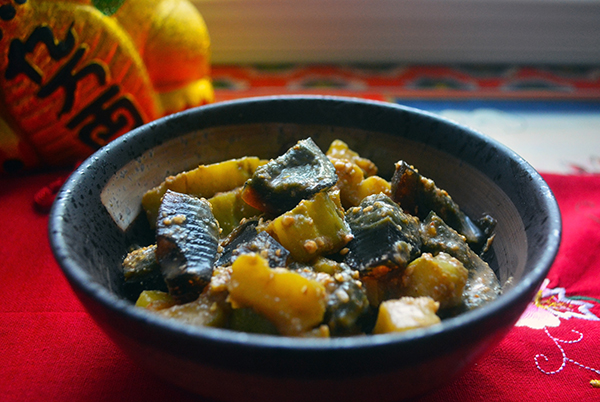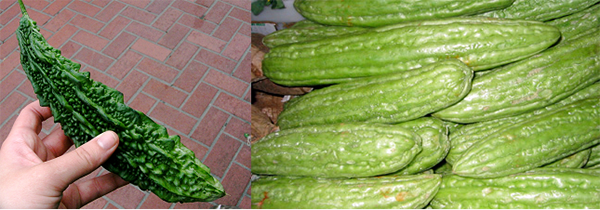This recipe takes two strange-flavored foods and combines them in a chilled salad or light dish in a way that makes them better together. For those of you not familiar with bitter melon, it is very well named and packs a wallop of natural bitterness. It is so bitter as to make your mouth pucker and to wonder why humans began eating this food in the first place. That said, cooks generally make it less bitter by blanching it in boiling water at least once before stir frying or sautéing it with other ingredients.

This easy Chinese/Taiwanese recipe simply blanches it twice (in two changes of water) and then combines it with the pidan, and a thick, flavorful dressing of sesame paste, soy sauce, strong tea and hoisin sauce or broad-bean paste. The only optional seasoning is a bit of ground white pepper and salt. This combination is then chilled for about an hour and the dish is served chilled or cold, according to one’s tastes.
The sesame gives an earthy flavor to the bitter melon (which is only a little bit bitter after being twice blanched) and the soy provides a bit of salt a lot of savoriness to bring together the bitter melon and the pungent pidan. Within the hoisin is a bit of garlic and vinegar as well as toasted soybeans to work with the sesame paste to make a rich, delicious dressing. As noted above, broad-bean paste can be used in place of hoisin, it all juts depends upon what ingredients you have on hand or which flavors move you the most. With no further ado, the recipe:
1000-Year Eggs with Bitter Melon
Ingredients
2 medium bitter melons, pith and seeds removed
2 teaspoons hoisin sauce
3 teaspoons light soy sauce
3 teaspoons sesame paste
1 tablespoon hot, strong tea
3, 1000-Year Eggs
1 teaspoon freshly ground white pepper (or to taste) (optional)
¼ teaspoon of salt (or to taste) (optional)
2 teaspoons sesame seeds, lightly roasted (for garnish)
Directions
Heat water in two large saucepans for blanching the bitter melon. (Alternatively one can blanch in two changes of water and cool the melon in between by rinsing with cold water). Cut the bitter melon into thin strips (between one-quarter and one-half inch) crosswise. When water has boiled, place the bitter melon slices in the water, cover and return to a boil. Cook for about 3 -4 minutes.
If using the two pot method, after 3-4 minutes has elapsed, transfer the slices to the second pot of boiling water with a slotted spoon or small metal sieve. Cook for another 3 minutes in the second pot and then drain and rinse under cold water. If using the one-pot method, drain the slices into a colander after the first blanching, and rinse with cold water. Refill the pot and return to the stove. Cover and boil water. When water has boiled, blanch the bitter melon slices for a second time, for about 3-4 minutes. Drain and rinse under cold water.
Peel 1000-Year eggs, roughly dice, and set aside.
In a small bowl or cup, mix hoisin sauce, soy sauce, sesame paste and hot tea until well combined. Pour over bitter melon slices and mix well. If using, add white pepper and salt. Then add 1000-year eggs and stir well once again. Refrigerate covered for an hour. Plate and garnish with sesame seeds just before serving.
Variations: Works well with broad-bean paste in place of the hoisin sauce. One can also, easily omit the pepper for an earthy, sesame-scented salad.
_____
This is a great dish for a hot summer’s day. I like to serve it chilled, but not cold to allow the flavors to really shine. It does need to be eaten fairly quickly after being chilled, especially if using white pepper, because this will come to dominate the dish as the eggs and vegetables sit in the dressing.
About Bitter Melon
Bitter melon comes in a variety of shapes and sizes. There are several small cultivars in South Asia that are small – usually no larger than about 6 or 7 inches long, and that have highly wrinkled skin. These come in varying shades of green, from white to a light lime color, to a deep, almost forest green. The cultivar from China tends to be a light green in color, is much larger than the South Asian cultivars (it can be more than 1-foot-long) and has a gently undulating, warty surface. For this recipe, I used two medium Chinese cultivars.

For most Chinese or Taiwanese dishes, one slices the bitter melon lengthwise, removes the pith and the seeds and prepares the green rind with the firmly attached hard, white inner skin on the underside. In addition to coupling bitter melon with 1000-Year Eggs, many recipes cook it with pork, or douchi (fermented black beans). The melons are also used in herbal teas and as a bittering agent for some beers in China and Japan.
One of the many interesting things about bitter melon is that is rich in substances such as charantin, visine, and polypeptide-p that function as insulin-analogs, and it is used as treatment for type-2 diabetes in several forms of traditional medicine. Recent scientific studies, however, are divided as to whether there is a glucose-lowering effect with regular ingestion. Some studies, like the one in the Journal of Ethnopharmacology in January 2011 and in the March 2008 issue of Chemistry and Biology found that it significantly lowered blood-glucose levels or increased cellular uptake of glucose (same thing, but two different measurements), while other, earlier studies, showed little positive effect of eating bitter melon.
This is potentially good news that another diet-based treatment option for diabetes may be on the way for some. However, it should serve as a note of caution to those with insulin-dependent diabetes, who should be mindful of eating too-much bitter melon on a regular basis, so that they don’t over-control their illness and induce hypoglycemia. That said, however, an intermittent serving or two will not hurt.
Bitter melon is also high in minerals such as calcium, potassium and magnesium. So, this dish is interesting, and good for you too! (Words and recipe by Laura Kelley, Photograph of 1000-Year Eggs with Bitter Melon by Laura Kelley; Photographs of South Asian and Chinese Bitter Melon Cultivars from Wikipedia.)
